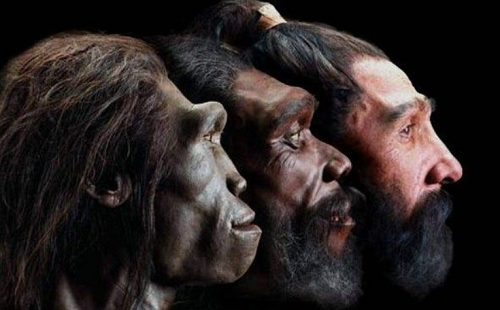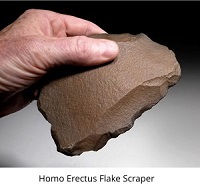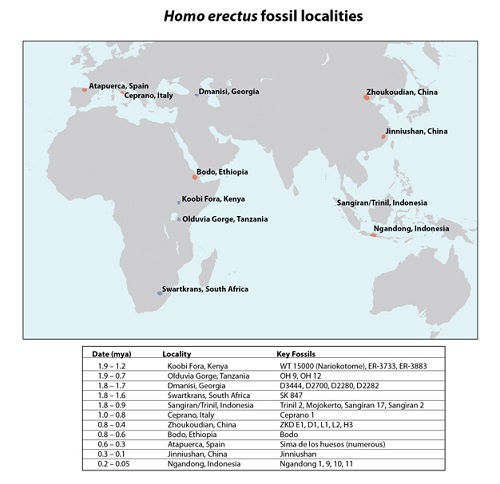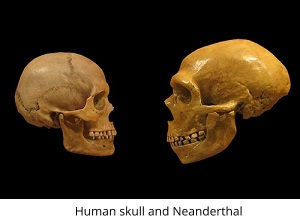Time Periods
Archaic humans began using stone tools about 2.6 million years ago. This period of time is called the Stone Age and is divided into 4 distinct periods; the Paleolithic (Old Stone), Mesolithic (Middle Stone), Epipalaeolithic (Final Old Stone) and Neolithic (New Stone). In a confusing fashion, there are no hard and fast dates for these time periods. Instead, dating varies within a geographic region and the development of the cultures within that region.
The exception is the Epipalaeolithic which denotes a transitional time period, 20,000 to 10,000 BC, where the nomadic hunter-gatherers made rapid changes towards building permanent structures, the refinement of stone tools, and the beginning of farming and the domestication of animals. These rapid changes have been called the 'Neolithic Revolution.' This generally coincides with the end of the Younger Dryas mini-ice age when glaciers receded to the north throughout Europe and the Mid-East.

Homo erectus
Homo erectus (also called Homo ergaster) fossils are the oldest known early humans. Homo erectus had an exceptionally long time range between 1.9 million years ago to 110,000 years ago at the end of which it coexisted with Homo sapien. The oldest fossils have been found throughout Africa with slightly more recent fossils found in West Asia (Georgia) and East Asia (China and Indonesia). Java Man and Peking Man are examples of Homo erectus found in those regions.
Homo erectus (man upright) is considered the first specics that was more human than ape. Apes were only about 3 ft tall while Homo erectus was over 5 ft tall. Home erectus had more human like body proportions with arms and torso closer to humans than apes, his skull was more round like modern humans and he lived on the ground walking upright.
 Homo erectus is credited with some of the most basic, primative advances such as stone cutting tools; handaxes and cleavers. And it was during the time range of Homo erectus we see the first use of fire likely for cooking, warmth and to keep large predators away.
Homo erectus is credited with some of the most basic, primative advances such as stone cutting tools; handaxes and cleavers. And it was during the time range of Homo erectus we see the first use of fire likely for cooking, warmth and to keep large predators away.
It is thought that isolated populations of Homo erectus evoled through random mutations to produce later hominin species such as Homo heidelbergensis and ultimately to our own species Homo sapiens.

When we look at the five oldest Homo erectus fossil locations three are in Africa (Kenya, Tazania and South Africa), one is in Eastern Europe (Georgia) and one is in Indonesia. All five locations are dated either 1.9 or 1.8 million years ago. Given that the dating between the five locations only differ by 100,000 years it's possible that Homo erectus evolved in isolation at multiple geographical areas during the same time period.
Homo heidelbergensis
Homo heidelbergensis fossils are dated 800,000 BC to 200,000 BC and have been found in Europe and Africa. They had a height of 5' 9" and a larger braincase than Homo erectus. They had definite control of fire building fireplaces, used wooden spears with stone points and hunted large game animals including horses, deer, elephants and rhinos. They were the first to build shelters out of wood and also the first to live in colder climates.
Based upon DNA analysis Homo heidelbergensis is thought to be the 'most recent common ancestor' for both Homo neanderthal and Homo sapiens having diverged about 400,000 years ago. It is speculated that the European branch of Homo heidelbergensis mutated into Homo neanderthalensis and the African branch into Homo Sapiens.
Homo neanderthalensis
Neanderthals lived in Europe, the Mid-East and central Asia from 400,000 years ago to 40,000 years ago. They represented a dramatic change in the physical; they tended towards being short and stocky, had a large brain case, thick bony eyebrows and no chin. Neanderthals are modern human's closest relative although they went extinct about 40,000 years ago.

When people think of a 'caveman' they are thinking of the Neanderthals. Wearing crude animal hides, building fires, living in caves and hunting large animals with stone tipped spears. The height of their technology was creating stones with a sharp cutting edge which could be used to butcher animals.
DNA is a fragile molecule which degrades over time. It is best preserved in cold or frozen, dry climates; the oldest DNA comes from a woolly mammoth found frozen in the permafrost dating over one million years ago. The oldest hominin DNA recovered comes from a Neanderthal around 400,000 years old which is very near the beginnings of the Neanderthal species.
DNA has been extracted from more than a dozen Neanderthals and in 2010 the Neanderthal Genome Project released a report on the sequenced Neanderthal genome. This female genome showed that her parents were likely half siblings and that she had high rates of incestuous pairings. This is likely due to her living in a small and isolated population having limited interaction with other groups of Neanderthals.

It was found that modern humans contain approximately 2% Neanderthal with some geographical regions as high as 4%. However, Africans contain 0.3% Neanderthal genes which is essentially none. This indicates that Neanderthals developed outside Africa. Most Neanderthal fossils have been found in Europe with a decreasing number of fossils as you go eastward towards the Mid-East and Asia.
Neanderthals are extinct but there never were very many of them. Population estimates are wildly speculative but perhaps as few as 3,500 female Neanderthals existed at any one time. Their extinction happened only a few thousands of years after modern humans appeared on the scene and it is thought that their small population along with competition from modern humans likely contributed to their extinction.
Denisovan
A new archaic human has been identified from DNA analysis alone. Excavations in the Denisova Cave in Siberia, Russia revealed a handful of fossil specimens of five distinct individuals of this previously unknown human ancestor. This cave was named after a Christian hermit, Dyonisiy (Denis) who lived in the cave in the 1800s. The findings are so recent this ancient ancestor has not received an official name but simply goes by the name Denisovan although it will likely be designated Homo denisovan. Over a period of several hundred thousand years this cave was inhabited by Neanderthals, Denisovans and modern humans.
Of the five Denisovan fossils the oldest, found in the cave's East Chamber, dates to 217,000 years ago. Another sample has been dated to 195,000 years ago. A fossilized fragment of a long bone has been designated as 'Denny' and is from 90,000 year ago of a 13 year old girl. This young girl, Denny, was a first generation hybrid between a Denisovian father and a Neanderthal woman. Additionally, her genome suggests that her father also carried a small degree of Neanderthal ancestry from some 500 earlier generations.
A partial mandible discovered in 1980 in Tibet, in the Baishiya Karst Cave was found to have close affiliation to that of the Denisovans using ancient protein analysis. The sample was 160,000 years old. Neanderthals and Denisovans are extinct but they were both partly assimilated into modern day humans. Up to 4% Neanderthal genes are found in some geographic regions such as Europe and Asia. The Denivosian genes are found in Siberia, Tibet, Indonesia, Papua New Guinea, the Philippines, Australia and and even on Pacific islands like Fiji. It appears that Modern Papuans (Papua New Guinea) have as much as 6% Denisovian genes but it is likely that there were two separate groups of Denisovans contributing to their genes separated from one another by 350,000 years. The Denisovan genome indicated the Denisovans had dark skin, brown hair, and brown eyes.
So modern humans closest relatives are the Neanderthals and the Denisovians with many people living today have a small amount of genetic material from these distant ancestors. The Neanderthals ranged from Western Europe to Russia and the Denisovians ranged from Russian eastward throughout South East Asia, Southern China, the Philippine Islands, Australia and the Pacific Islands. Hundreds of thousands of years ago the Denisovans were seafaring!
